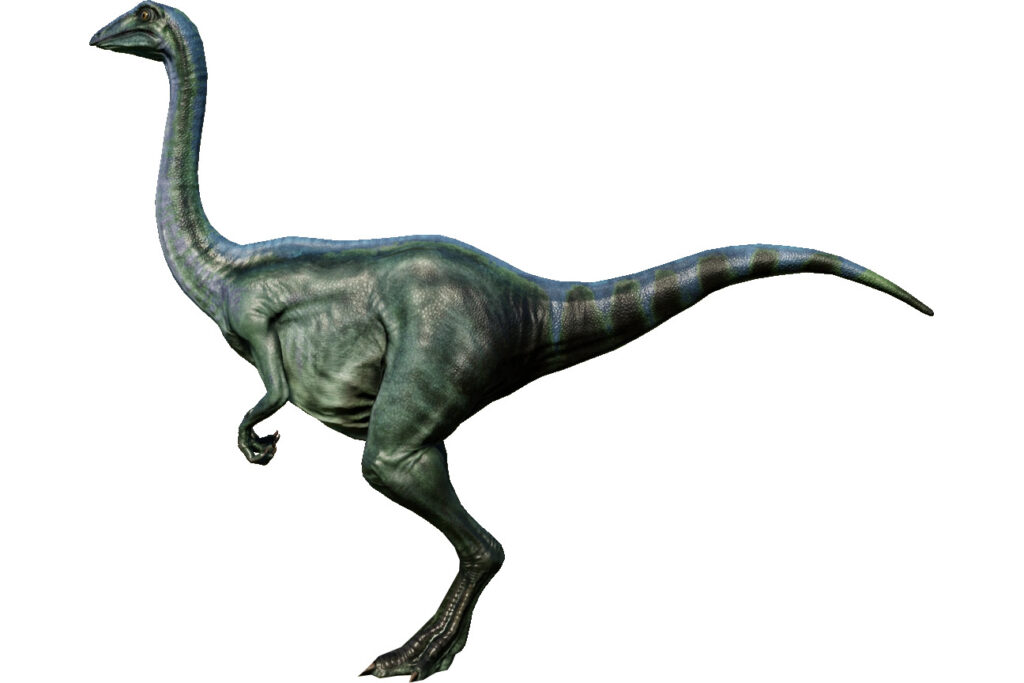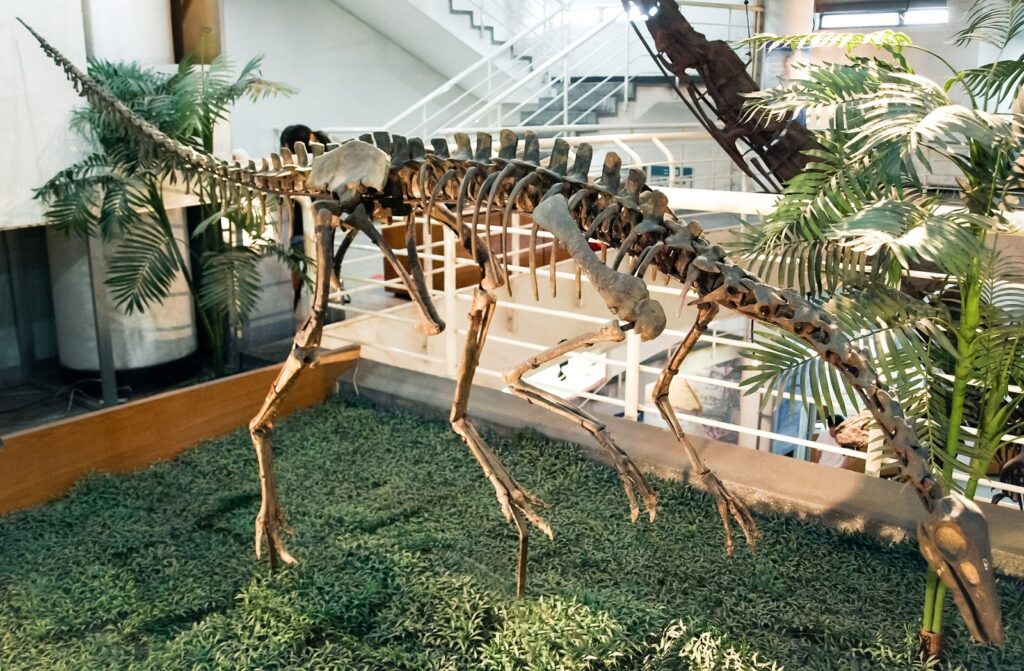Introduction
The late Cretaceous period was an era teeming with diverse and awe-inspiring creatures. Among them, Archaeornithomimus stood out as an intriguing dinosaur. Its name, derived from the Greek words “archaio” meaning ancient, “ornithos” meaning bird, and “mimos” meaning mimic, alludes to its bird-like characteristics. This dinosaur, first discovered in the 1960s, continues to captivate paleontologists and dinosaur enthusiasts alike.
Key Attributes of Archaeornithomimus

| Name | Archaeornithomimus |
|---|---|
| Size | Approximately 3 meters (10 feet) in length |
| Age | Late Cretaceous (approximately 70 to 66 million years ago) |
| Diet | Omnivorous, with a diet that likely included both plant material and small prey |
| Classification | Kingdom: Animalia, Phylum: Chordata, Class: Sauropsida, Superorder: Dinosauria, Order: Saurischia, Suborder: Theropoda, Family: Ornithomimidae, Genus: Archaeornithomimus |
| Habitat | Open plains and forested areas |
| Distribution | Found in Asia, specifically in Mongolia and China |
| Unique Features | Slender body, long neck, toothless beak, and long legs for fast running |
| Behavior | Believed to be an agile and omnivorous dinosaur |
| Predators | Shared its ecosystem with larger carnivorous dinosaurs, such as Tyrannosaurus rex |
| Cultural Significance | Important in understanding the diversity of ornithomimid dinosaurs |
| Fossil Record | Well-preserved fossils discovered in Mongolia and China, providing insights into its anatomy and evolutionary relationships |
Discovery
Unearthing the Fossils
The story of Archaeornithomimus began when paleontologists embarked on expeditions to the Gobi Desert of Mongolia. These expeditions aimed to uncover the remnants of ancient life buried beneath the desert sands. It was during one of these excavations that researchers stumbled upon the first traces of Archaeornithomimus.
Initial Insights
Upon closer examination of the fossils, paleontologists were astonished by the unique characteristics they discovered. The skeletal remains of Archaeornithomimus hinted at a dinosaur unlike any other previously known. The excitement surrounding this find sparked further investigations and a quest for a deeper understanding of this mysterious creature.
Expanding Discoveries
As time progressed and additional fossil discoveries were made, the picture of Archaeornithomimus began to take shape. These new findings provided researchers with more complete skeletons, allowing for a comprehensive analysis of its anatomy and behaviors. The continuous expansion of knowledge surrounding Archaeornithomimus fueled a deeper appreciation for the diversity that once existed during the late Cretaceous period.
Description
Anatomy and Physical Characteristics
The physical characteristics of Archaeornithomimus paint a vivid picture of this remarkable dinosaur. With a slender and lightweight body, it measured around 13 to 16 feet in length and weighed approximately 300 to 400 pounds. Its long and agile limbs, particularly the hind legs, were indicative of its ability to move swiftly.
Bird-Like Adaptations
Archaeornithomimus possessed several adaptations that evoked similarities to modern-day birds. These adaptations included hollow bones, which reduced weight while maintaining structural integrity, and a wishbone, or furcula, which enhanced stability during flight or rapid movements. The presence of these avian characteristics added to the intrigue surrounding this dinosaur.
Beak and Teeth
One of the most distinctive features of Archaeornithomimus was its beak-like snout. This specialized structure, combined with its sharp teeth, suggests a diet that encompassed a wide range of foods. Recent scientific research indicates that Archaeornithomimus was an omnivorous dinosaur, able to consume both plant matter and small animals.
Habitat
Late Cretaceous Environment
Archaeornithomimus thrived in the late Cretaceous period, a time marked by varying environmental conditions. This period witnessed diverse ecosystems ranging from lush forests to arid and semi-arid regions. The changing landscapes presented both challenges and opportunities for the dinosaurs that inhabited these areas.
Mongolia and China

The fossils of Archaeornithomimus were primarily discovered in the Gobi Desert of Mongolia, which was part of a vast interconnected region spanning Mongolia and China during the late Cretaceous. These regions were characterized by their unique geological formations, including deserts, ancient river systems, and areas of volcanic activity.
Adaptation to Arid and Semi-Arid Conditions
Archaeornithomimus successfully adapted to the arid and semi-arid conditions prevalent in its habitat. Its lightweight build and efficient respiratory system likely aided in conserving water and tolerating the dry climate. This adaptability played a crucial role in the survival and proliferation of this unique dinosaur species.
Diet
Omnivorous Feeding Strategy
The discovery of Archaeornithomimus as an omnivorous dinosaur challenged previous assumptions about the diets of its theropod relatives. This adaptability allowed Archaeornithomimus to exploit a broader range of food sources, granting it an evolutionary advantage.
Plant Consumption
As an omnivore, Archaeornithomimus consumed various plant materials. It is believed to have fed on ferns, fruits, seeds, and other vegetation found in its habitat. The ability to supplement its diet with plant matter contributed to its survival and adaptability in changing environmental conditions.
Insect and Small Animal Prey
In addition to plant material, Archaeornithomimus also preyed upon insects and small animals. Fossils of this dinosaur provide clues about its feeding behaviors, indicating a potential ability to capture and consume invertebrates and possibly even small vertebrates. This versatile diet allowed Archaeornithomimus to exploit available food sources effectively.
Behavior
Speed and Agility
Archaeornithomimus possessed remarkable speed and agility, characteristics essential for survival in its prehistoric world. Its long and powerful hind legs, combined with a lightweight body, allowed it to swiftly maneuver through its environment. These physical adaptations provided Archaeornithomimus with an advantage when chasing prey or evading predators.
Foraging Behaviors
The beak-like snout and sharp teeth of Archaeornithomimus suggest a foraging behavior, where it used its specialized jaws to extract and consume various food sources. Its omnivorous diet necessitated an ability to locate and gather plant materials, as well as capture small animals. The sensory adaptations of Archaeornithomimus likely aided in detecting and pursuing potential food sources.
Social Interactions
The social behaviors of Archaeornithomimus remain a subject of speculation due to the limited evidence available. However, it is plausible that these dinosaurs exhibited social interactions within their populations. Such interactions could have included mating rituals, communication, and potentially even herding behaviors. Future discoveries may shed further light on the social dynamics of this species.
Extinction
Late Cretaceous Changes
The late Cretaceous period was a time of significant changes, both geologically and biologically. Fluctuating sea levels, alterations in climate patterns, and the emergence of new species all contributed to the shifting dynamics of ecosystems. These changes impacted the survival and long-term prospects of many dinosaur species, including Archaeornithomimus.
Environmental Factors
Environmental factors, such as climate change and habitat disruption, likely played a role in the extinction of Archaeornithomimus. The alterations in vegetation patterns, availability of food sources, and potential changes in predator-prey relationships would have impacted the survival and reproductive success of this dinosaur species.
Competing Species
Competition for resources was a constant struggle for dinosaurs living in the late Cretaceous period. The emergence of new species and the diversification of existing ones presented challenges for Archaeornithomimus. Competing with other herbivorous or omnivorous dinosaurs for food sources could have put additional strain on its survival prospects.
Conclusion
Archaeornithomimus, the omnivorous dinosaur of the late Cretaceous period, continues to fascinate scientists and enthusiasts. Its unique characteristics, including its bird-like adaptations and omnivorous diet, set it apart from its contemporaries. The recent scientific discoveries and research have provided valuable insights into its anatomy, habitat, diet, behavior, and the challenges it faced before its eventual extinction.
As we continue to explore the prehistoric world, the study of dinosaurs like Archaeornithomimus deepens our understanding of the incredible diversity and adaptations of ancient life on Earth.
FAQs
1. What does “Archaeornithomimus” mean?
Archaeornithomimus is derived from Greek words meaning “ancient bird mimic.” The name reflects its bird-like characteristics.
2. Where were Archaeornithomimus fossils discovered?
Fossils of Archaeornithomimus were primarily discovered in the Gobi Desert of Mongolia, with additional finds in other regions of China.
3. What did Archaeornithomimus eat?
Archaeornithomimus had an omnivorous diet, consuming a variety of foods. It fed on plant material such as ferns, fruits, and seeds, while also preying upon insects and possibly small animals.
4. How fast could Archaeornithomimus run?
While exact speeds are challenging to determine, the lightweight build and long legs of Archaeornithomimus suggest it was a fast runner, potentially capable of swift movement to capture prey or evade predators.
5. What led to the extinction of Archaeornithomimus?
The extinction of Archaeornithomimus was likely influenced by a combination of environmental changes, competition for resources, and the overall dynamics of the late Cretaceous period. Further research is needed to fully understand the factors contributing to its demise.
